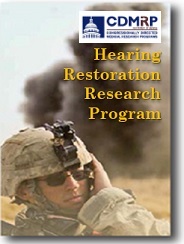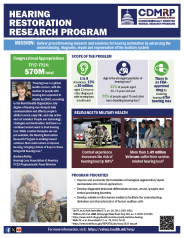Hearing Restoration
Vision – Reduce the burden of hearing loss on Service Members, Veterans, and the American public

» Click on Image to View Program Booklet

» Click on Image to View Strategic Plan

» Click on Image to View Program Summary Sheet
Hearing loss is a silent epidemic. 15% of adults aged 18 and over had some degree of hearing loss, making it the third most common chronic physical condition in the United States and more prevalent than diabetes (9%) or cancer (8%).1 Hearing loss is especially common among older adults, affecting nearly 25% of those aged 65-74 and 50% of those 75 or older. Although invisible, hearing loss has a significant impact on quality of life and is a major risk factor for social isolation, cognition decline, anxiety, and depression.
Service Members are exposed to high levels of noise, which significantly increases the risk for hearing loss.2 Hearing loss not only adversely impacts force readiness, survivability, and lethality of Service Members, but also has a profound effect on the quality of life of Veterans. Nearly 1.5 million Veterans are affected by service-connected disability due to hearing loss, making it one of the most common disabilities among Veterans.3
In recognition of the lack of effective treatment for hearing loss, the threat it poses to medical readiness of Service Members, the high costs to the Department of Defense and the Department of Veterans Affairs, and the magnitude of the challenge, Congress established the Hearing Restoration Research Program (HRRP) in FY17 to accelerate research and development in this critical area.
The HRRP invests in innovative research that advances the understanding of auditory injury and the repair and regeneration of the auditory system. The groundbreaking research funded by the HRRP will remove barriers to hearing restoration.
1Blackwell DL, Lucas JW, Clarke TC. (2014) Summary Health Statistics for U.S. Adults: National Health Interview Survey, 2012. Vital and Health Statistics. Series 10, No. 260. National Center for Health Statistics, Centers for Disease Control and Prevention.
http://www.cdc.gov/nchs/data/series/sr_10/sr10_260.pdf
2Wells TS, Seelig AD, Ryan MA, et al. 2015. Hearing Loss Associated with U.S. Military Combat Deployment. Noise Health. 17(74):34-42.
3Veterans Benefits Administration Annual Benefits Report, Fiscal Year 2023. (2024) Veterans Benefits Administration. U.S. Department of Veterans Affairs.
https://www.benefits.va.gov/REPORTS/abr/docs/2023-abr.pdf
Resources for Investigators:
- A Beginners Guide to Military Health Care (Audiology & Otolaryngology)
- Joint Health Services Publication JP 4-02
- Blast Term Dictionary and Guidance Documents for Blast Injury Research
- Defense Health Agency Strategic Research Plan: Sensory Systems
- A Primer for Conducting DOD Funded Human Research with Military Populations
- FY24 HRRP Funding Opportunity FAQ
![]()
Congressional Appropriations
- $65 million
FY17-23 - $5 million
FY24

Funding
Summary
- 61 Awards in
FY17-23 - Recent Applications Recommended for Funding

Programmatic
Panels

Peer Review Participants
Last updated Monday, March 17, 2025














